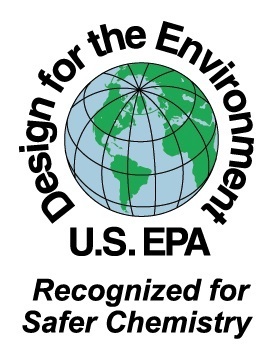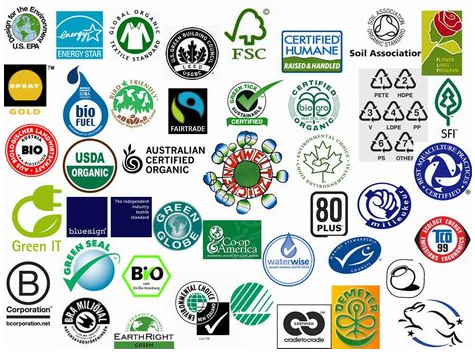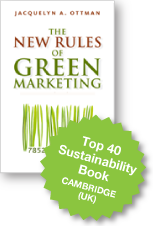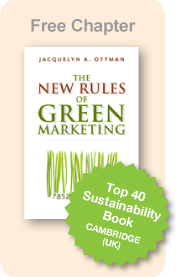Jacquie Ottman's
Green marketing Blog

EPA’s Design for the Environment Label — A Route to Safer Chemicals
Posted on November 21, 2011 by Jacquelyn Ottman
Some chemicals are safer than others, and the U.S. EPA’s Office of Pollution Prevention and Toxics’s voluntary Design for the Environment label can help consumers identify all purpose cleaners, laundry detergents and oth er products that have met performance measures and are known to contain the safest possible ingredients. Since its inception in 1997, the label has been earned by over 2700 products. (Full disclosure: DfE is a former client of mine.)
er products that have met performance measures and are known to contain the safest possible ingredients. Since its inception in 1997, the label has been earned by over 2700 products. (Full disclosure: DfE is a former client of mine.)
A product of EPA’s now twenty-year-old Design for the Environment (DfE) Program, the …Read more...
Why Education is Key to Green Marketing Success
Posted on October 26, 2011 by Jacquelyn Ottman
 Given the complexities of greening, properly educating consumers can make the difference in the success of a campaign. One green marketer who learned the hard way about the need to educate is Whirlpool. In the early 1990s they won a $30 million “Golden Carrot” award that was put up by the U.S. Department of Energy and a consortium of electrical utilities for being the first to market with a chlorofluorocarbon (CFC)-free refrigerator. But they misjudged consumer’s willingness to pay a 10% premium for …Read more...
Given the complexities of greening, properly educating consumers can make the difference in the success of a campaign. One green marketer who learned the hard way about the need to educate is Whirlpool. In the early 1990s they won a $30 million “Golden Carrot” award that was put up by the U.S. Department of Energy and a consortium of electrical utilities for being the first to market with a chlorofluorocarbon (CFC)-free refrigerator. But they misjudged consumer’s willingness to pay a 10% premium for …Read more...
How to Choose the Right Eco-label for Your Brand
Posted on October 19, 2011 by Jacquelyn Ottman
 Eco-labels are an excellent way to enhance credibility for green marketing claims, but they are not without risk. While 28% of consumers look to green certification seals or labels to confirm that a product adheres to claims, these labels can also confuse. Happily there’s enough method within the madness for marketers to pave a way forward.
Eco-labels are an excellent way to enhance credibility for green marketing claims, but they are not without risk. While 28% of consumers look to green certification seals or labels to confirm that a product adheres to claims, these labels can also confuse. Happily there’s enough method within the madness for marketers to pave a way forward.
Eco-labeling challenges
More than 400 different eco-labels or green certification systems are now on the market. Questions such as which label is better, which product is …Read more...
Toyota’s Prius: Different Strokes for Different Folks
Posted on October 12, 2011 by Jacquelyn Ottman
 The mainstreaming of green brings with it the need to segment audiences. As marketing efforts behind the Toyota Prius demonstrate, targeting messages to specific consumer groups can broaden appeal.
The mainstreaming of green brings with it the need to segment audiences. As marketing efforts behind the Toyota Prius demonstrate, targeting messages to specific consumer groups can broaden appeal.
When launching the Prius in 2001, Toyota opted to target not the green-leaning drivers one might expect, but rather tech-savvy “early adopter” consumers. Featuring a beauty shot of a shiny new car parked at a stop light and illustrated by the provocative headline, “Ever heard the sound a stoplight makes?” an introductory print ad …Read more...
Focus On Consumer Self-Interest to Win Today’s Green Customer
Posted on October 05, 2011 by Jacquelyn Ottman
If your green ads showcase the now tiresome images of babies, daisies, and planets, your messages will likely be irrelevant to mainstream consumers. Eco-imagery may have tugged at the purse-strings of “deep green” consumers, but their lighter green counterparts, who make up the bulk of the market, want to know how even the greenest of products benefit them personally. While the environment may be the underlying reason a product was created or upgraded, it will likely not be the primary motivation for consumers to choose your brand over those of …Read more...
Ideals on Wheels
Posted on September 28, 2011 by Jacquelyn Ottman
 In many cities bicyclists battle it out with taxis for a share of the road. But all Parisians seem to agree that bicycles are a convenient, cheap, trendy, and emission-free way for locals and tourists to get around town. Representing the biking equivalent of car sharing, in 2007 the city of Paris launched Vélib, a pay-as-you-go bicycle rental program.
In many cities bicyclists battle it out with taxis for a share of the road. But all Parisians seem to agree that bicycles are a convenient, cheap, trendy, and emission-free way for locals and tourists to get around town. Representing the biking equivalent of car sharing, in 2007 the city of Paris launched Vélib, a pay-as-you-go bicycle rental program.
Bikes can be rented for pre-paid amounts of time ranging from 30 minutes to one week, and then dropped off …Read more...
Doing Cause Marketing Right
Posted on September 20, 2011 by Jacquelyn Ottman
Once considered a short-term promotional tactic, cause marketing is now a mature, long-term strategic business practice that can enhance brand image and boos t sales. Most importantly, cause-related products give businesses an impact that goes far beyond mere tax-deductible checks (philanthropy).
t sales. Most importantly, cause-related products give businesses an impact that goes far beyond mere tax-deductible checks (philanthropy).
Several successful brands are making social causes central to their business. Consider the enormously successful TOMS One for One campaign, which gives a pair of shoes to a child in need for every pair of their rubber-soled alpargatas shoes they …Read more...
Why Empowering Children is Key to Green Marketing Success
Posted on September 06, 2011 by Jacquelyn Ottman
 Good green marketing is all about making an investment in the future of the planet by promoting sustainability and protecting the environment. So it is only natural that successful green marketing campaigns can and should involve children, offering an opportunity for building life-long brand loyalty.
Good green marketing is all about making an investment in the future of the planet by promoting sustainability and protecting the environment. So it is only natural that successful green marketing campaigns can and should involve children, offering an opportunity for building life-long brand loyalty.
TerraCycle, the innovative New Jersey outfit founded by Princeton University dropout Tom Szaky, first made headlines in 2006 by selling fertilizer made from worm poop to The Home Depot and other major retailers. They …Read more...
Don’t Let Skepticism Stifle Your Green Efforts
Posted on August 10, 2011 by Jacquelyn Ottman
 Ask businesses why they don’t tout green achievements more often, and their answer will likely be fear of greenwash.
Ask businesses why they don’t tout green achievements more often, and their answer will likely be fear of greenwash.
Before you let such fears deter you from making investments in sustainable technology or promoting your green achievements, consider how difficult it is for any advertiser to gain consumer trust.
Consumers have always been skeptical of advertising. Take the food industry, for example. Food brands have long been under government scrutiny for their advertising claims. Today, companies are getting smeared for overpromising health benefits, …Read more...
Earth to Eco-Labels: Be Consumer Useful or Wither From Lack of Relevance
Posted on August 10, 2011 by Jacquelyn Ottman
Everyone lauds eco-labels being put forth by such sustainability leaders as Timberland, HP and Levi’s for transparency and commitment, but are they really all that useful to consumers? Likely not. These labels may be informative and project credibility, but I believe their usefulness can—and must—be taken up a notch.
An eco-label’s greatest value is not its ability to simply convey environmental stewardship; rather, an eco-label’s worth lies in how clearly it relates green qualities to what I call “consumer-useful” information. Labels with consumer-useful information put the practical, valuable aspects …Read more...
Why Guilt Won’t Sell Green
Posted on August 01, 2011 by Jacquelyn Ottman
 In the midst of a national energy crisis in 1978, U.S. president Jimmy Carter took to the airwaves in a cardigan sweater encouraging Americans to conserve energy by turning the thermostat to 68º F. His campaign failed because of its link to deprivation, and because it represented a threat to the upward mobility and prosperity that is America.
In the midst of a national energy crisis in 1978, U.S. president Jimmy Carter took to the airwaves in a cardigan sweater encouraging Americans to conserve energy by turning the thermostat to 68º F. His campaign failed because of its link to deprivation, and because it represented a threat to the upward mobility and prosperity that is America.
While some may question the idea that “bigger is better,” most Americans have not historically been willing to reverse their hard-won struggles to “have” for a …Read more...
40% Off The New Rules of Green Marketing to Mark Top 40 Status
Posted on July 25, 2011 by Jacquelyn Ottman

As many of you know, The New Rules of Green Marketing was recently named a Top 40 Sustainability Book of 2010 by the Cambridge University (UK) Program for Sustainability Leadership. This honor is …Read more...
How Consumers Can Share Responsibility for Greening
Posted on July 18, 2011 by Jacquelyn Ottman
 Tom’s of Maine can make the toothpaste more natural, but they can’t force consumers to turn the water off when they brush. Coke can make the bottles recyclable, but only consumers can drop them in the blue bin. Sun Chips can make the bags compostable, but only consumers can see that they get to a composting pile instead of a trash can.
Tom’s of Maine can make the toothpaste more natural, but they can’t force consumers to turn the water off when they brush. Coke can make the bottles recyclable, but only consumers can drop them in the blue bin. Sun Chips can make the bags compostable, but only consumers can see that they get to a composting pile instead of a trash can.
Communications can fill this gap. With life cycle risks escalating over time, green marketers must now educate their consumers on how to …Read more...
Running On Human Power
Posted on July 11, 2011 by Jacquelyn Ottman
While researchers are  looking to the sun, the wind and even ocean tides to source renewable energy, some have found an answer much closer to home: the gym. This notion dawned on the owner of a string of gyms in Hong Kong, who rigged cycling and cross-training machines to power a gym’s lights and store extra energy in batteries for later use.
looking to the sun, the wind and even ocean tides to source renewable energy, some have found an answer much closer to home: the gym. This notion dawned on the owner of a string of gyms in Hong Kong, who rigged cycling and cross-training machines to power a gym’s lights and store extra energy in batteries for later use.
The Human Power Trainer, made by Windstream Power LLC of North Ferrisburg, Vermont, works on the same concept. It mounts a …Read more...
Let the Consumer Decide “What is Green?”
Posted on July 01, 2011 by Jacquelyn Ottman
 You hear a lot of talk about the “sin of the hidden trade-offs.” I’ve got news for you, folks. Greening—like life itself—is all about the trade-offs! No product is 100% “green.” So, considering that all products use energy and create waste, green is a relative term. One product is green-er for someone at some time in some place.
You hear a lot of talk about the “sin of the hidden trade-offs.” I’ve got news for you, folks. Greening—like life itself—is all about the trade-offs! No product is 100% “green.” So, considering that all products use energy and create waste, green is a relative term. One product is green-er for someone at some time in some place.
Green is Relative
For instance, cloth diapers might not cause any trees to be chopped down, but they do use a lot of hot …Read more...

